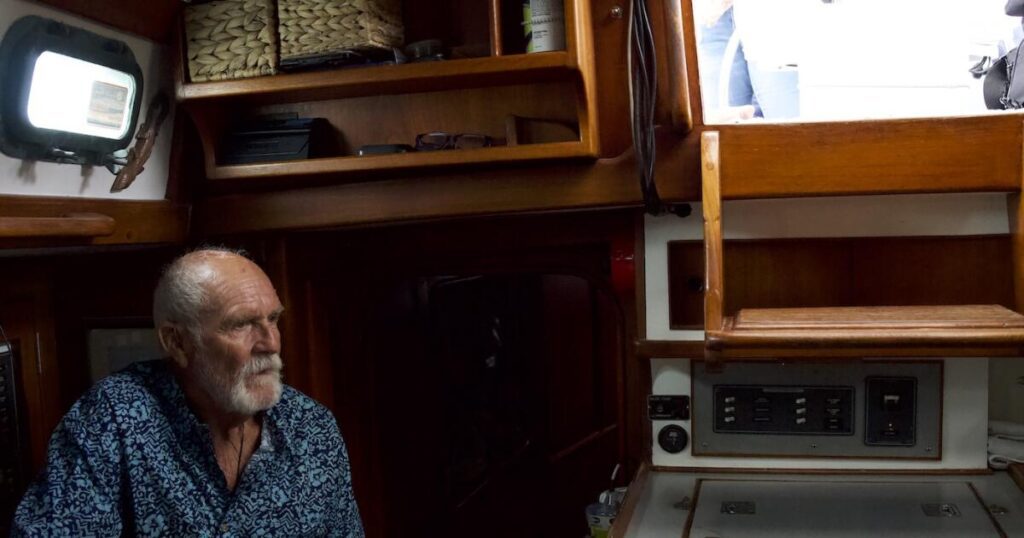Jerry and Kathy McGraw said they narrowly avoided being abducted by pirates.
Like many others in expensive Southern California, the McGraws have opted to live on their boat, where they can avoid high rents, pull up anchor when they want a different view and chase adventure in their golden years.
“You know, if you have itchy feet or you don’t like your neighbor that you’re parked next to, then you just pick up and you go, you have some new adventure,” said Kathy McGraw.
Mooring in marinas from Mexico to French Polynesia and beyond, the McGraws have lived aboard their boats for over 25 years and traveled across the world. The couple have learned from trying times that boat life is not always an easy life.

Jerry McGraw takes the couple’s dinghy to shore.
(Elizabeth Carroll)
The couple have since settled in Newport Harbor with a wealth of maritime tales, including a time they narrowly missed a pirate attack.
Just yards away from their boat docked in the Philippines, they said 12 to 15 armed people entered the marina by boat and took hostage four people.
“It ended up that the two Canadian men were beheaded,” Jerry McGraw said.
Even with the frightening encounters and hardships, for the McGraws, along with many liveaboards along the California coast, boat life is the only life.
As liveaboards, people live on their boats as a form of alternative housing, similar to that of van life or tiny homes. Some opt for the lifestyle as a more affordable, stationary option to living, while others dream of sailing miles of open waters.
Jerry McGraw is a retired member of the Newport Sheriff’s Department and Harbor Patrol. Kathy McGraw is a former boat racer and member of the Women’s Sailing Group. The couple said they have always had a love for the ocean. Now, mooring their boat closer to family in their hometown of Newport Beach is ideal.
As Kathy McGraw approaches 69, and Jerry McGraw turns 78, Kathy McGraw acknowledged that they will “have to live on land one day because [they] won’t be able to do this [forever].”

Kathy McGraw peers out into Newport Harbor, where she lives aboard the Po’oino Roa with her husband, Jerry.
(Elizabeth Carroll)
“It always makes me really sad,” Kathy McGraw said. “When you have a boat, you get really connected to it.”
Mooring on an offshore anchorage in the middle of the open water, as opposed to living in a slip, offers no shared amenities or WiFi.
Similar to his fellow Newport Harbor neighbors, Michael Spano likens living on a slip to van life, where liveaboards can easily walk on and off the docks whenever they would like.
“People in the mooring field, man, they eat, sleep and breathe boats,” said Spano, who moors in Newport Harbor. “It’s a whole different animal.”
After falling in love with spearfishing and sailing, Spano said living on a boat was the “natural next step.”
He saw plenty of free vessels advertised on Craigslist and came to the conclusion that “getting a boat was not an issue; the issue was parking a boat.”

Michael Spano at the wheel of his boat.
(Courtesy of Michael Spano)
“I learned about the mooring [buoy] in Newport Beach and it’s a really sweet deal,” Spano said. “It was very economical, like it’s for the average Californian and I was like, ‘oh, that’s what I need to do,’ because if I were to get a slip in Newport, it’s just outrageous.
“It’s not for real people,” Spano continued. “It’s for the most elite of elite. The costs are astronomical.”
Spano bought his mooring permit for $40,000 three years ago and pays roughly $192 a month in taxes to the city, where average home values are over $3 million and average rent in the area is over $4,000 a month, according to Zillow.com. Since moving onto his boat, Spano has sailed to Mexico twice, and he joined his neighbor in sailing throughout French Polynesia.
“I wanted to be as close as I could to the water and it was just the most common sense way to afford that lifestyle,” Spano said. “And I was willing to put up with the sacrifices that it came with.”
Carroll, Greenberg, Morgan, Perry and Villalobos are studying for master’s degrees in journalism at USC Annenberg. This article is part of their larger study into the liveaboard lifestyle along Southern California’s coast.”

